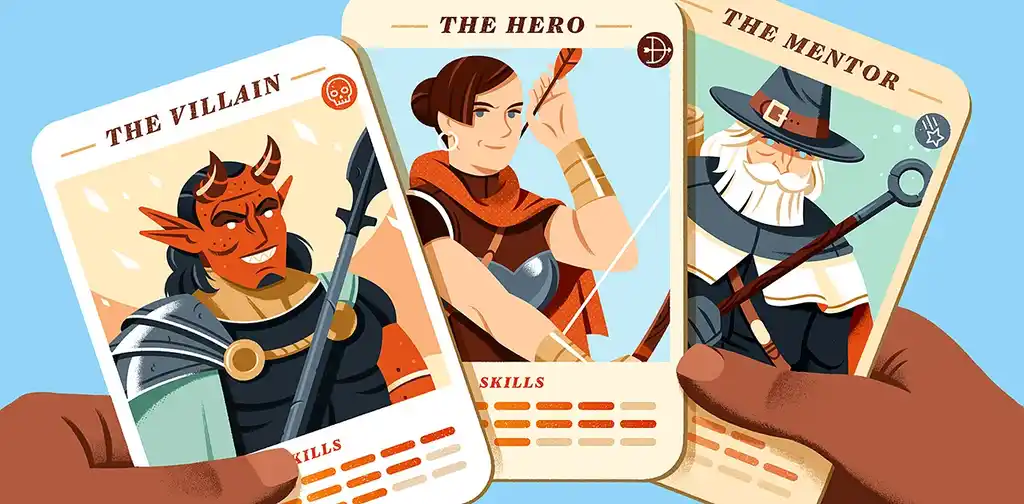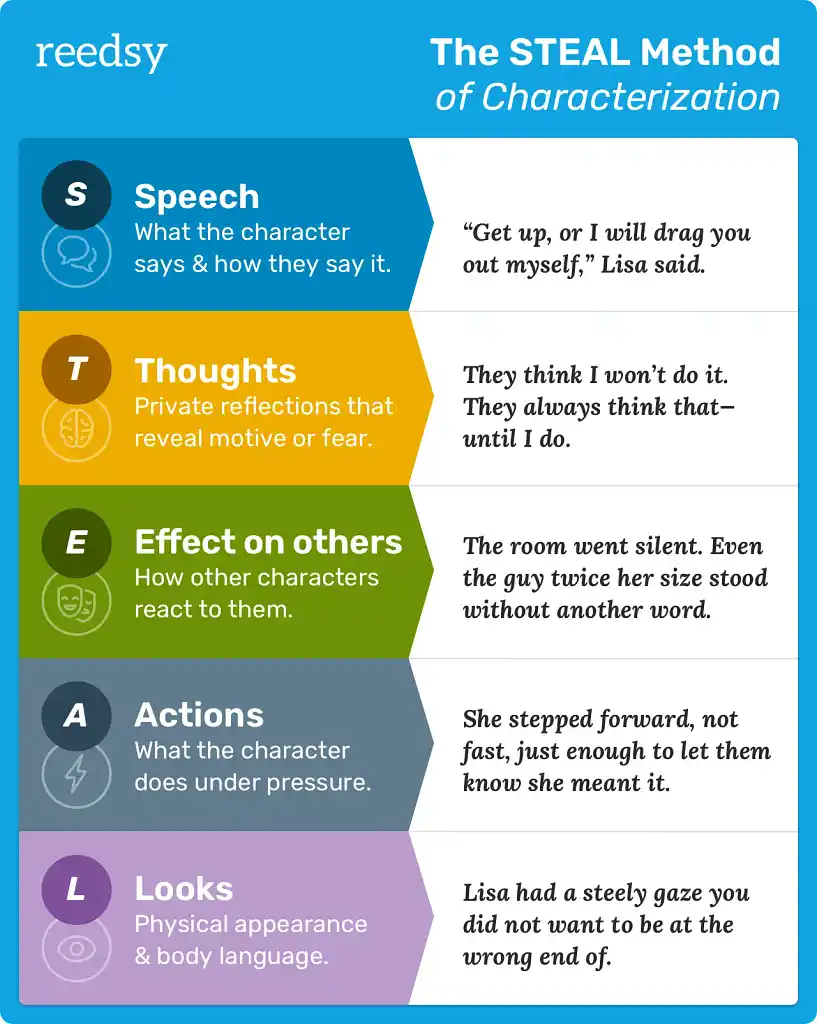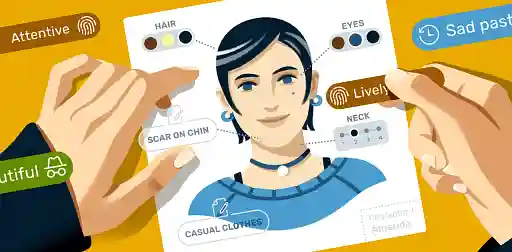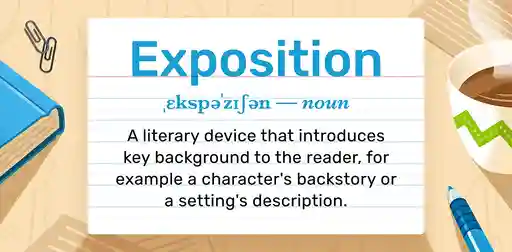Posted on May 15, 2025
Indirect Characterization: Definition, Examples, and Tips
Linnea Gradin
The editor-in-chief of the Reedsy Freelancer blog, Linnea is a writer and marketer with a degree from the University of Cambridge. Her focus is to provide aspiring editors and book designers with the resources to further their careers.
View profile →Dario Villirilli
Editor-in-Chief of the Reedsy blog, Dario is a graduate of Mälardalen University. As a freelance writer, he has written for many esteemed outlets aimed at writers. A traveler at heart, he can be found roaming the world and working from his laptop.
View profile →Indirect characterization is a technique that shows readers who your characters are through their actions, interactions, thoughts, and dialogue — letting their behavior reveal their personality, rather than simply telling the reader through direct statements.
In this post, we'll explore what indirect characterization is and how to effectively use it to create fully rounded characters, including how to apply the popular STEAL (speech, thought, effect, action, and looks) method.

FREE RESOURCE
Reedsy’s Character Profile Template
A story is only as strong as its characters. Fill this out to develop yours.
What is indirect characterization?
Indirect characterization is when an author uses actions and behaviours to implicitly show, instead of telling the reader who a character is. That is, instead of using explicit statements like “Belinda was always happy-go-lucky,” you could talk about how “Belinda always seemed to be on the verge of laughter, smiling brightly at the world around her and lighting up every room she entered.”
This approach allows readers to infer the character's qualities bit by bit, simulating the layered, dynamic experience of meeting someone in real life.
Let’s look at a few examples from modern literature.
3 indirect characterization examples
In Beach Read by Emily Henry, we meet January and Augustus, two rival authors who, over the course of a summer, challenge each other to try to write in each other’s genre. January is grieving and has a wall up against Augustus based on past events. Henry shows the reader her guarded personality through her actions:
January didn’t smile, not even when Gus did. It was a small thing, but it was like a crack in the door to something that wouldn’t let her let go. She watched him with her arms crossed tight, eyes narrowed, and a little frown that told Gus she wasn’t buying what he was selling.
Likewise, in The Ballad of Songbirds and Snakes, Hunger Games-author Suzanne Collins gives insight into the character Coriolanus in the following passage:
Coriolanus reached for the mint tea, careful not to spill a drop on the tablecloth. He folded his napkin precisely, smoothing the crease with two fingers before placing it on his lap. Across the room, a classmate laughed with their mouth open. He looked away.
This quote subtly hints at Coriolanus’s demeanour and appearance — controlled, neat, and proper — all without explicitly stating it. His precise movements, attention to detail, and judgmental glance at someone else’s lack of refinement tell us he is meticulous, image-conscious, and quietly disdainful.
Ocean Vuong similarly applies indirect characterization in his novel The Emperor of Gladness to give insight into his character’s emotional state and their internal struggles:
You stood in the kitchen, one hand pressed to the fridge as if holding it closed could keep the milk from spoiling. The radio played an old song no one could name, and you hummed along, off-key, your mouth barely moving.
The metaphor of holding the fridge closed to keep the milk from spoiling shows a quiet resistance to deal with an inevitable situation, and suggests an emotional fragility. The old song playing in the background and the passionless humming reinforces the image of a character stuck in their past.
So, how is this different from direct characterization? Let’s take a look.
Direct vs. indirect characterization
Direct characterization is when an author makes straightforward statements like, "John was always angry and quick to snap." This approach tells the reader exactly what the character is like in an explicit way.
On the other hand, as we’ve seen, indirect characterization uses implicit ways of portraying the character, like action, habits, thoughts, and interactions with others, and their development over time.
You can think of it a bit like a mirror vs. a window. Direct characterization is like holding up a mirror and telling the reader, “Look, this is who the character is.” Indirect characterization, however, is like giving the reader a window to peek through as the character goes through their day.
👀 Check out our companion post on direct characterization for more examples of how the same character trait can be expressed directly and indirectly.
Both direct and indirect characterization are perfectly valid approaches to writing characters, but they serve different purposes and have different impacts on the reader. As an author, you’ll want to be intentional about which method you use and when.
Pros and cons of indirect characterization
Whereas direct characterization is great when you want to quickly relay information, indirect characterization shines when it comes to painting a nuanced picture of your character’s inner world and personality and when you want to speak to your readers’ emotions.
Just think about the difference between writing “Bobby was sad,” and writing “Bobby felt like he had a hole where his heart used to be, nothing could make him smile anymore, and it was as if the skies had decided to remain grey forever.” These two sentences both have their time and place but the emotional resonance is completely different.
Indirect characterization is often more evocative and effective in bringing the character truly to life than direct characterization as it reflects how we actually get to know people in real life: little by little, and by observing each other’s behaviours. It also encourages reader engagement by inviting the reader to draw their own conclusions about your characters. It’s a bit like the proof in the pudding, backing up any direct claims you might have made about who your character is by showing it in action.

GET ACCOUNTABILITY
Meet writing coaches on Reedsy
Industry insiders can help you hone your craft, finish your draft, and get published.
5 tips for indirect characterization
Before you go off to write your own amazingly unique characters, here are some general tips and reminders to make sure you get the most out of your indirect characterizations.
1. Apply the STEAL-method
When showing who your character is, it can be helpful to focus on five areas: speech, thought, effect (on others), actions, and looks — also known as the STEAL-method.
Below is a brief look at each of these five areas:
- Speech: What a character says and how they say can reveal a lot about their background, emotions, and intentions.
- Thoughts: A character’s internal monologue can offer a window into their true emotions, desires, and fears. Internal contradictions, passing thoughts, and deeper ponderings, can add depth to the character.
- Effect on others: The way other characters react to your protagonist or the impact that their actions have on the world is another way to indirectly describe what they are like.
- Actions: What a character does in any given situation, but particularly tense ones, reveals more than what they might say.
- Looks: You can use someone’s looks to indirectly describe their personality, mindset, and emotional state.

2. Pay attention to consistency
When using indirect characterization, your character's traits should align with what you want the reader to understand about them. If your character is meant to be kind, their actions should reflect that kindness, even if it’s shown through indirect methods. There’s room for contradiction (more on this below) but a character who is inherently shy won’t suddenly act confidently without a reason.
3. Use contradiction to indicate growth and complexity
Just like people are full of contradictions, so are great characters. As long as the contradictions align with the central picture you’re painting of your character, this can actually be a great way to create nuance and show character growth. Maybe your protagonist starts out timid but slowly becomes braver as the story progresses — these subtle shifts in characterization will make their growth feel more natural.
4. Use literary devices for more impact
To make your indirect characterization more impactful, use literary devices to convey emotions and traits without directly stating them. Metaphors and similes can evoke feelings more vividly — for example, instead of saying a character is "nervous," you might describe their anxiety as “a storm brewing just beneath the surface.” Symbolism can also add depth, like a cracked mirror symbolizing a character's fractured self-perception.
5. Be specific and original
Lastly, to truly bring your character to life, you’ll want to give them enough recognizable traits to feel like someone readers might know — but also bring out what makes them unique and distinctly them. To do so, it can help to focus on details like a small scar the character got as a child which they keep rubbing when they’re lost in thought, or maybe they smell of paint stripper and petrol, suggesting they work a manual labor. By highlighting original quirks and behaviors like these, you can reveal more about your character in a natural way, making them feel authentic and complex.
5 prompts to practice your craft
Before you go, try applying what you’ve learnt in this article by testing one or all of the following practice exercises.
- 🗣️ Write a short dialogue where a character lies, but don’t use the word “lie.” Focus on their speech and how it betrays them.
- 💭 Write a short scene where a character’s thoughts contradict their actions and/or speech.
- 👀 Write a scene from the perspective of another character, describing their reaction to the protagonist without mentioning the protagonist’s traits.
- ⚡️ Write a scene where a character faces a crisis. Focus solely on their actions to reveal their emotional state (no internal thoughts).
- 🚶♀️Describe a character entering a room. Focus on their posture, clothing, and physical traits and try to convey their mood and personality through these cues.
Using direct and indirect characterization correctly is a skill that takes time to develop. If you want to practice in a fun and low-pressure environment, check out our weekly short story contest. With some practice, you'll soon develop an instinct for when and how to use one or the other. Until then, consider working with professional editors to shorten the process of mastering it.
Hire an expert
Penny S.
Available to hire
Deputy Chief Editor then Director of the Oxford English Dictionary; 23 years at the OUP. Now editing texts for a varied range of authors.
Amy S.
Available to hire
Friendly, thorough, supportive editor/proofreader for your novel. Experience in romance, historical, LGBTQIA+, mystery, YA, sci-fi, fantasy.
Sarah K.
Available to hire
I'm a British Asian Cambridge-educated editor and author with over 20 years experience in publishing.
And there you have it. Indirect characterization is one of the most powerful tools in a writer’s toolkit, which you can use to build a deeper, more authentic connection between your readers and your characters. Remember: great characters are made through subtlety, not through on-the-nose descriptions. Keep experimenting with the STEAL-method, and soon your characters will jump off the page in ways you never expected.






